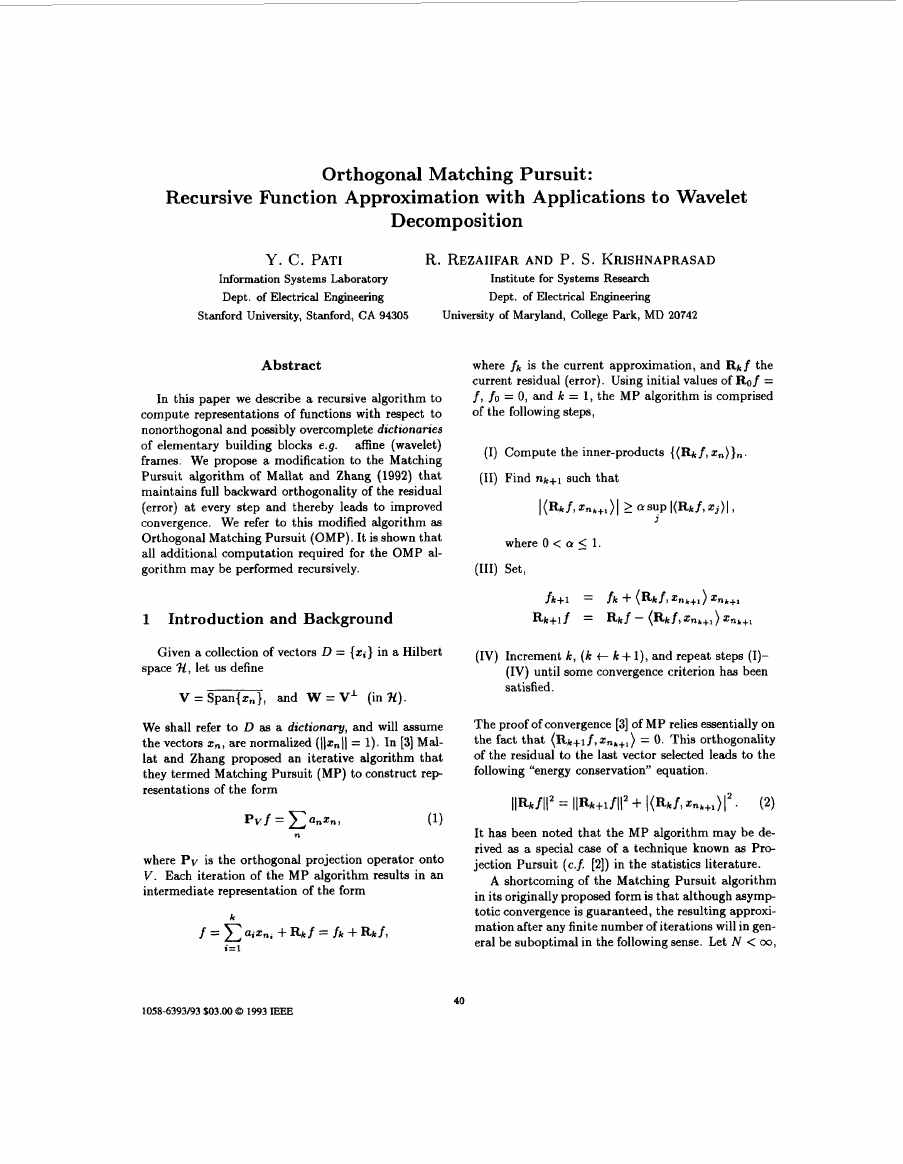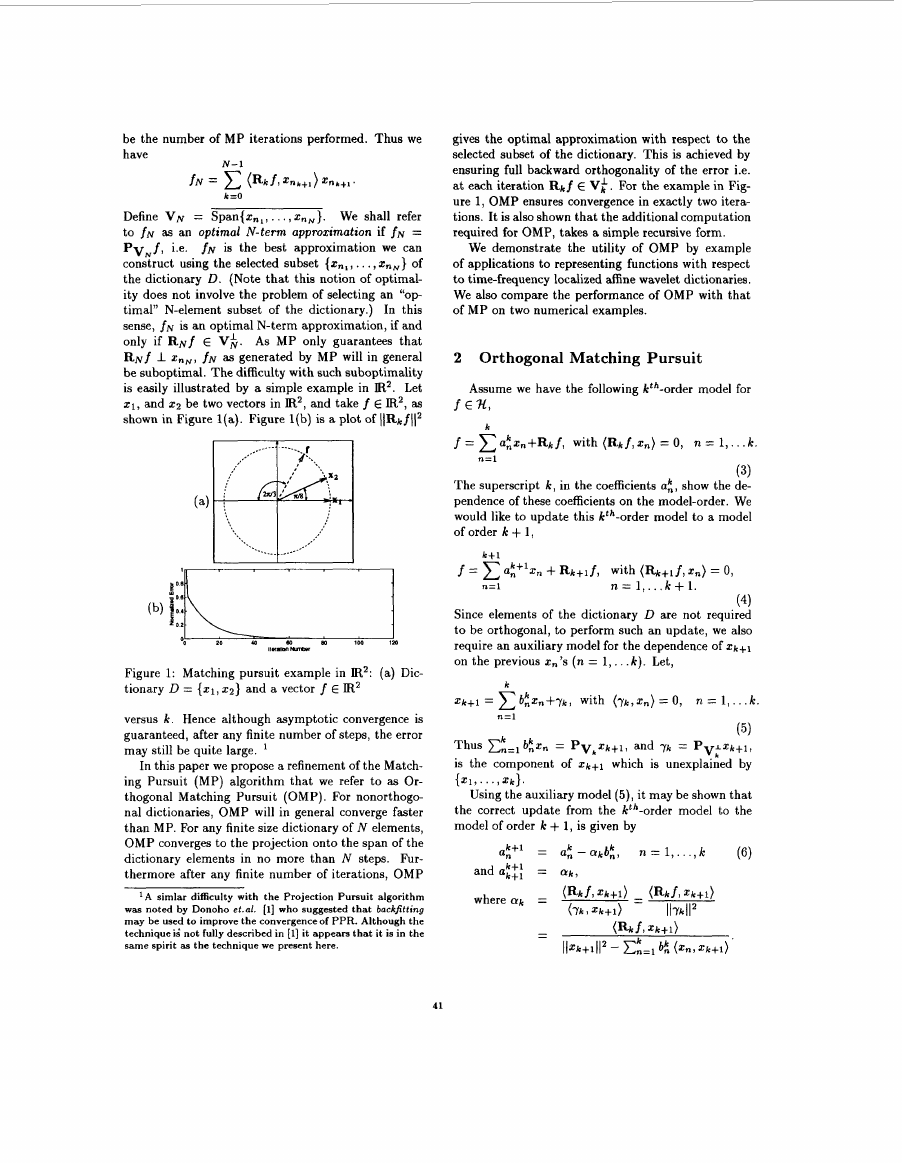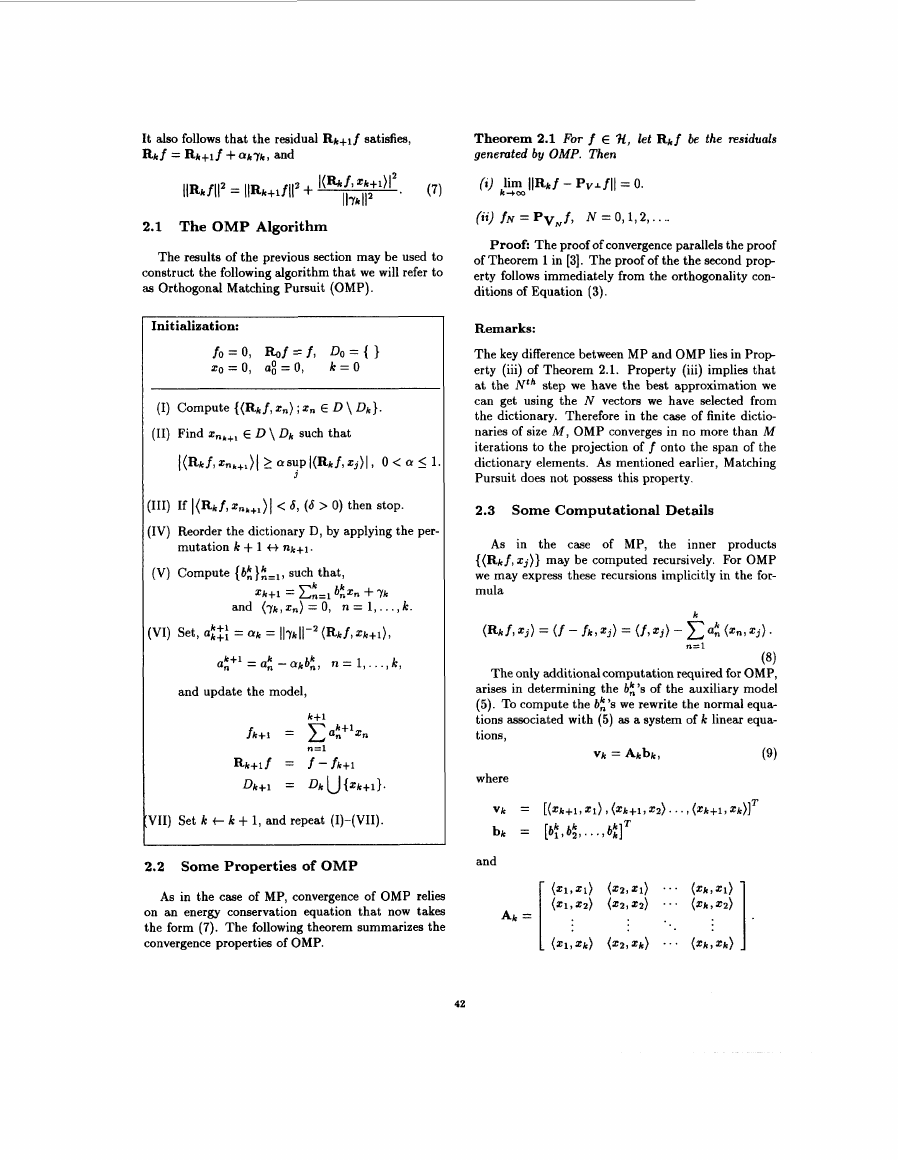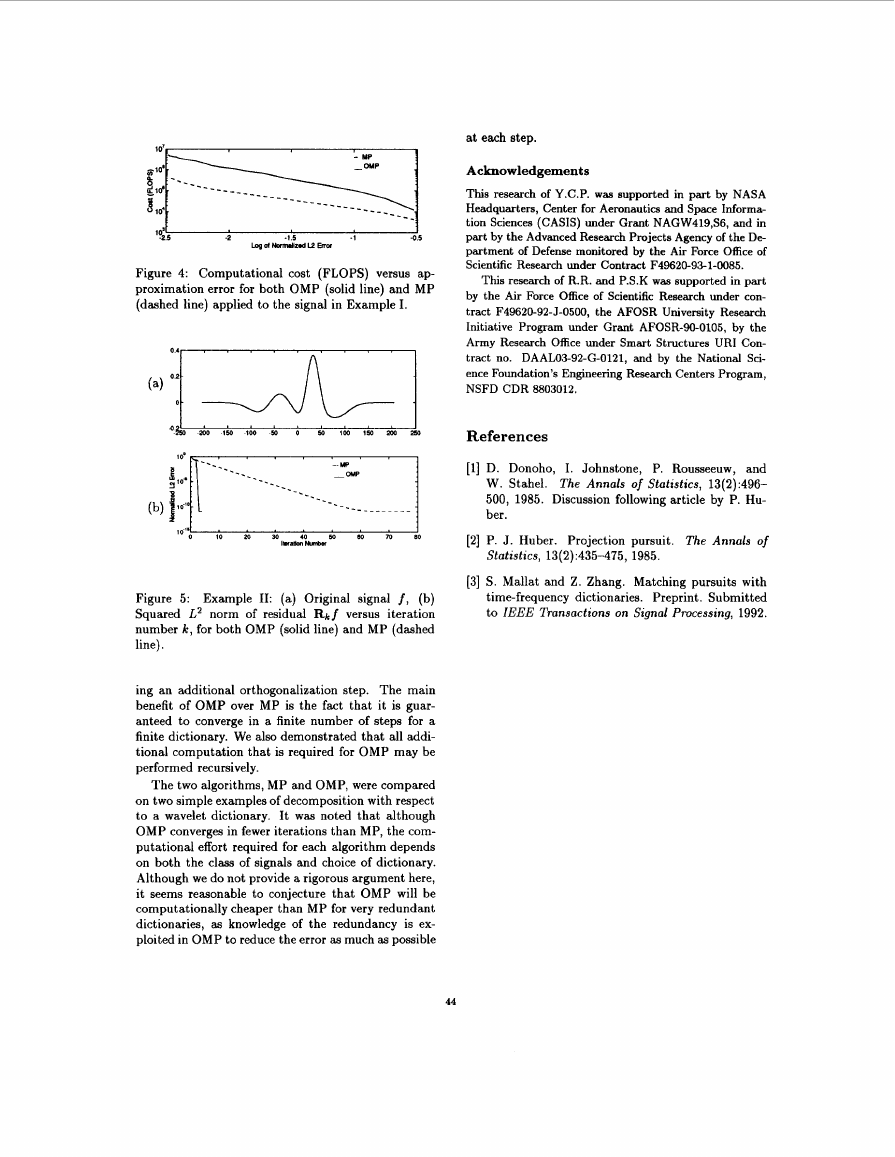Recursive Function Approximat ion with Applications to Wavelet
Orthogonal Matching Pursuit:
Decomposition
Y. C. PATI
Information Systems Laboratory
Dept. of Electrical Engineering
Stanford University, Stanford, CA 94305
R. REZAIIFAR AND P. s. KRISHNAPRASAD
Institute for Systems Research
Dept. of Electrical Engineering
University of Maryland, College Park, MD 20742
Abstract
In this paper we describe a recursive algorithm to
compute representations of functions with respect to
nonorthogonal and possibly overcomplete dictionaries
of elementary building blocks e.g.
affine (wavelet)
frames. We propose a modification to the Matching
Pursuit algorithm of Mallat and Zhang (1992) that
maintains full backward orthogonality of the residual
(error) at every step and thereby leads to improved
convergence. We refer to this modified algorithm as
Orthogonal Matching Pursuit (OMP). It is shown that
all additional computation required for the OMP al-
gorithm may be performed recursively.
1 Introduction and Background
Given a collection of vectors D = {xi} in a Hilbert
space R, let us define
V=Span{z,},
and W = V '
(inR).
We shall refer to D as a dictionary, and will assume
the vectors xn, are normalized (llznII = 1). In [3] Mal-
lat and Zhang proposed an iterative algorithm that
they termed Matching Pursuit (MP) to construct rep-
resentations of the form
Pvf = C a n z n ,
n
(1)
where PV is the orthogonal projection operator onto
V. Each iteration of the MP algorithm results in an
intermediate representation of the form
where fk is the current approximation, and Rk f the
current residual (error). Using initial values of Ro f =
f , fo = 0, and k = 1 , the M P algorithm is comprised
of the following steps,
(I) Compute the inner-products {(Rkf, Zn)},.
(11) Find nktl such that
I(Rkf,
' n k + I ) l 2 asYp I(Rkf, zj)I 1
where 0 < a 5 1.
(111) Set,
(IV) Increment k, (k t IC + l), and repeat steps (1)-
(IV) until some convergence criterion has been
satisfied.
The proof of convergence [3] of MP relies essentially on
= 0. This orthogonality
the fact that (Rk+lf, z ~ ~ + ~ )
of the residual to the last vector selected leads to the
following "energy conservation" equation.
IIRkfl12 = llRk+lf112 + I(Rkf12nk+1)12'
(2)
It has been noted that the MP algorithm may be de-
rived as a special case of a technique known as Pro-
jection Pursuit (c.f, [2]) in the statistics literature.
A shortcoming of the Matching Pursuit algorithm
in its originally proposed form is that although asymp
totic convergence is guaranteed, the resulting approxi-
mation after any finite number of iterations will in gen-
eral be suboptimal in the following sense. Let N < 00,
1058-6393193 $03.00 Q 1993 IEEE
40
�
gives the optimal approximation with respect to the
selected subset of the dictionary. This is achieved by
ensuring full backward orthogonality of the error i.e.
at each iteration Rkf E Vi. For the example in Fig-
ure 1, OMP ensures convergence in exactly two itera-
tions. It is also shown that the additional computation
required for OMP, takes a simple recursive form.
We demonstrate the utility of OMP by example
of applications to representing functions with respect
to time-frequency localized affine wavelet dictionaries.
We also compare the performance of OMP with that
of MP on two numerical examples.
2 Orthogonal Matching Pursuit
Assume we have the following kth-order model for
f EN,
k
f = x Q a f n + R k f , with (Rk f , f n ) = 0, 71 = 1,. . .k.
n=l
(3)
The superscript k, in the coefficients a t , show the de-
pendence of these coefficients on the model-order. We
would like to update this kth-order model to a model
of order k + 1,
f = Qk+lz, -I- & + i f , with (&+if, fn) = 0,
n = l , ... k + l .
k+l
n = l
(4)
Since elements of the dictionary D are not required
to be orthogonal, to perform such an update, we also
require an auxiliary model for the dependence of Xk+l
on the previous t,’~ ( n = 1,. . . k). Let,
k
fk+1 =
b;fn+7k, with (yk,xn) = 0,
72 = 1,. . .k.
n = l
(5)
Thus ~ “ , l b ~ z , = PVkzk+l, and 7 k = p vk L f k + l ,
is the component of z k + l which is unexplained by
( 2 1 , . . . , f k } .
Using the auxiliary model (5), it may be shown that
the correct update from the kth-order model to the
model of order k + 1, is given by
be the number of MP iterations performed. Thus we
have
N-1
f N =
(Rkf, f n k + , )
k=O
Define VN = Span{znl,.. . , xnN}. We shall refer
to fN as an optimal N-term approximation if fN =
PVNf’ i.e.
fN is the best approximation we can
construct using the selected subset {2n1, . . . , Z n N } of
the dictionary D. (Note that this notion of optimal-
ity does not involve the problem of selecting an “op
timal” N-element subset of the dictionary.) In this
sense, f~ is an optimal N-term approximation, if and
only if RNf E V;.
As MP only guarantees that
RN f 1 f n N , fN as generated by MP will in general
be suboptimal. The difficulty with such suboptimality
is easily illustrated by a simple example in IR2. Let
z1, and 2 2 be two vectors in IR2, and take f E Et2, as
shown in Figure l(a). Figure l(b) is a plot of llRkfllz
Figure 1: Matching pursuit example in IR2: (a) Dic-
tionary D = ( 1 1 , Q} and a vector f E Et2
versus k. Hence although asymptotic convergence is
guaranteed, after any finite number of steps, the error
may still be quite large.
In this paper we propose a refinement of the Match-
ing Pursuit (MP) algorithm that we refer to as Or-
thogonal Matching Pursuit (OMP). For nonorthogo-
nal dictionaries, OMP will in general converge faster
than MP. For any finite size dictionary of N elements,
OMP converges to the projection onto the span of the
dictionary elements in no more than N steps. Fur-
thermore after any finite number of iterations, OMP
A simlar difficulty with the Projection Pursuit algorithm
was noted by Donoho et.ol. [l] who suggested that bockfitting
may be used to improve the convergenceof PPR. Although the
techniqueii not fully described in [l] it appears that it is in the
same spirit as the technique we present here.
41
�
It also follows that the residual &+If
R k f = R k + l f -k O k y k , and
satisfies,
Theorem 2.1 For f E 3, let R k f be the residuals
genemted by OMP. Then
2.1 The OMP Algorithm
The results of the previous section may be used to
construct the following algorithm that we will refer to
as Orthogonal Matching Pursuit (OMP).
Initialization:
fo = 0, Rof=f, Do = { 1
20 = 0, a: = 0,
k = O
:III) If I ( R k f , z n r + l ) l < 6, (6 > 0) then stop.
:IV) Reorder the dictionary D, by applying the per-
mutation k + 1 C) n k + l .
(V) Compute {bk,}k=l, such that,
z k + 1 = zn=l bkzn -k yk
k
and (Cyk,Z,) = 0,
= Qk = llykll-2 ( R k f , Z k + l ) ,
n = I , . . .,k.
n = 1,. ..,k,
[VI) Set,
Oi+l = k
k
0, - Q k b n ,
and update the model,
k + l
a
~
"
n = l
fk+l = ~
R k + l f = f - f k + l
D k + l = D k U { z k + l } .
VII) Set k t k + 1, and repeat (1)-(VU).
~
n
2.2 Some Properties of OMP
As in the case of MP, convergence of OMP relies
on an energy conservation equation that now takes
the form (7). The following theorem summarizes the
convergence properties of OMP.
(il) fN = PvN f, N = 0, I, 2,. . ..
Proof: The proof of convergence parallels the proof
of Theorem 1 in [3]. The proof of the the second prop
erty follows immediately from the orthogonality con-
ditions of Equation (3).
Remarks:
The key difference between MP and OMP lies in P r o p
erty (iii) of Theorem 2.1. Property (iii) implies that
at the N t h step we have the best approximation we
can get using the N vectors we have selected from
the dictionary. Therefore in the case of finite dictio-
naries of size M, OMP converges in no more than M
iterations to the projection of f onto the span of the
dictionary elements. As mentioned earlier, Matching
Pursuit does not possess this property.
2.3 Some Computational Details
in
As
the case of MP,
inner products
{ ( R k f, zcj)} may be computed recursively. For OMP
we may express these recursions implicitly in the for-
mula
the
( R k f y z j ) = ( f - f k , z j ) = (f,zj) -
k
(%,zj).
n = l
(8)
The only additional computation required for OMP,
arises in determining the bi's of the auxiliary model
(5). To compute the hi's we rewrite the normal equa-
tions associated with ( 5 ) as a system of k linear equa-
tions,
v k = A k b k ,
(9)
where
and
42
�
Note that the positive constant 6 used in Step (111)
of OMP guarantees nonsingularity of the matrix Ak,
hence we may write
bk = Ak'Vk.
(10)
However, since Ak+l may be written as
(where * denotes conjugate transpose) it may be
shown using the block matrix inversion formula that
100,
I
,
,
,
,
,
,
,
,
1
where P = 1/(1 - vibk). Hence
and therefore
bktl, may be computed recursively using A;', and
bk from the previous step.
Figure 2: Example I : (a) Original signal f, with OMP
approximation superimposed, (b) Squared L2 norm of
residual Rkf versus iteration number k, for both OMP
(solid line) and MP (dashed line).
3 Examples
In the following examples we consider represen-
tations with repect to an affine wavelet frame con-
structed from dilates and translates of the second
derivate of a Gaussian, i.e. D = {$m,", m,n E Z}
where,
$m,"(C) = 242$(2% - n),
and the analyzing wavelet $J
is given by,
Note that for wavelet dictionaries, the initial set of in-
ner products {(f, $m,n)}, are readily computed by one
convolution followed by sampling at each dilation level
m. The dictionary used in these examples consists of
a total of 351 vectors.
In our first example, both OMP and MP were a p
plied to the signal shown in Figure 2(a). We see from
Figure 2(b) that OMP clearly converges in far fewer
iterations than MP. The squared magnitude of the co-
efficients o k , of the resulting representation is shown in
Figure 3. We could also compare the two algorithms
on the basis of required computational effort to com-
pute representations of signals to within a prespecified
error. However such a comparison can only be made
for a given signal and dictionary, as the number of it-
erations required for each algorithm depends on both
the signal and the dictionary. For example, for the
signal of Example I, we see from Figure 4 that it is 3
43
-80
-60 4 0 -P 0
a0
Tnnl.icn Indm
40
80
80
Figure 3: Distribution of coefficients obtained by ap-
plying OMP in Example I. Shading is proportional to
squared magnitude of the coefficients ah, with dark
colors indicating large magnitudes.
to 8 times more expensive to achieve a prespecified er-
ror using OMP even though OMP converges in fewer
iterations. On the other hand for the signal shown
in Figure 5, which lies in the span of three dictionary
vectors, it is approximately 20 times more expensive
to apply MP. In this case OMP converges in exactly
three iterations.
4 Summary and Conclusions
In this paper we have described a recursive al-
gorithm, which we refer to as Orthogonal Matching
Pursuit (OMP) , to compute representations of signals
with respect to arbitrary dictionaries of elementary
functions. The algorithm we have described is a mod-
ification of the Matching Pursuit (MP) algorithm of
Mallat and Zhang [3] that improves convergence us-
�
at each step.
Acknowledgements
This research of Y.C.P. was supported in part by NASA
Headquarters, Center for Aeronautics and Space Informa-
tion Sciences (CASK) under Grant NAGW419,S6, and in
part by the Advanced Research Projects Agency of the De-
partment of Defense monitored by the Air Force Office of
Scientific Research under Contract F49620-93-1-0085.
This research of R.R. and P.S.K was supported in part
by the Air Force Office of Scientific Research under con-
tract F49620-92-J-0500, the AFOSR University Research
Initiative Program under Grant AFOSR-90-0105, by the
Army Research Office under Smart Structures URI Con-
tract no. DAAL03-92-G-0121, and by the National Sci-
ence Foundation's Engineering Research Centers Program,
NSFD CDR 8803012.
References
[l] D. Donoho, I. Johnstone, P. Rousseeuw, and
W. Stahel. The Annals of Statistics, 13(2):496-
500, 1985. Discussion following article by P. Hu-
ber.
[2] P. J . Huber. Projection pursuit. The Annals of
Statistics, 13(2):435-475, 1985.
[3] S. Mallat and Z. Zhang. Matching pursuits with
time-frequency dictionaries. Preprint. Submitted
to IEEE Transactions on Signal Processing, 1992.
I 0'
- HP
1
- - - - I
Figure 4: Computational cost (FLOPS) versus ap-
proximation error for both OMP (solid line) and MP
(dashed line) applied to the signal in Example I.
Figure 5: Example 11: (a) Original signal f , (b)
Squared L2 norm of residual Rkf versus iteration
number IC, for both OMP (solid line) and MP (dashed
line).
ing an additional orthogonalization step. The main
benefit of OMP over MP is the fact that it is guar-
anteed to converge in a finite number of steps for a
finite dictionary. We also demonstrated that all addi-
tional computation that is required for OMP may be
performed recursively.
The two algorithms, MP and OMP, were compared
on two simple examples of decomposition with respect
to a wavelet dictionary. It was noted that although
OMP converges in fewer iterations than MP, the com-
putational effort required for each algorithm depends
on both the class of signals and choice of dictionary.
Although we do not provide a rigorous argument here,
it seems reasonable to conjecture that OMP will be
computationally cheaper than MP for very redundant
dictionaries, as knowledge of the redundancy is ex-
ploited in OMP to reduce the error as much as possible
44
�










 2023年江西萍乡中考道德与法治真题及答案.doc
2023年江西萍乡中考道德与法治真题及答案.doc 2012年重庆南川中考生物真题及答案.doc
2012年重庆南川中考生物真题及答案.doc 2013年江西师范大学地理学综合及文艺理论基础考研真题.doc
2013年江西师范大学地理学综合及文艺理论基础考研真题.doc 2020年四川甘孜小升初语文真题及答案I卷.doc
2020年四川甘孜小升初语文真题及答案I卷.doc 2020年注册岩土工程师专业基础考试真题及答案.doc
2020年注册岩土工程师专业基础考试真题及答案.doc 2023-2024学年福建省厦门市九年级上学期数学月考试题及答案.doc
2023-2024学年福建省厦门市九年级上学期数学月考试题及答案.doc 2021-2022学年辽宁省沈阳市大东区九年级上学期语文期末试题及答案.doc
2021-2022学年辽宁省沈阳市大东区九年级上学期语文期末试题及答案.doc 2022-2023学年北京东城区初三第一学期物理期末试卷及答案.doc
2022-2023学年北京东城区初三第一学期物理期末试卷及答案.doc 2018上半年江西教师资格初中地理学科知识与教学能力真题及答案.doc
2018上半年江西教师资格初中地理学科知识与教学能力真题及答案.doc 2012年河北国家公务员申论考试真题及答案-省级.doc
2012年河北国家公务员申论考试真题及答案-省级.doc 2020-2021学年江苏省扬州市江都区邵樊片九年级上学期数学第一次质量检测试题及答案.doc
2020-2021学年江苏省扬州市江都区邵樊片九年级上学期数学第一次质量检测试题及答案.doc 2022下半年黑龙江教师资格证中学综合素质真题及答案.doc
2022下半年黑龙江教师资格证中学综合素质真题及答案.doc